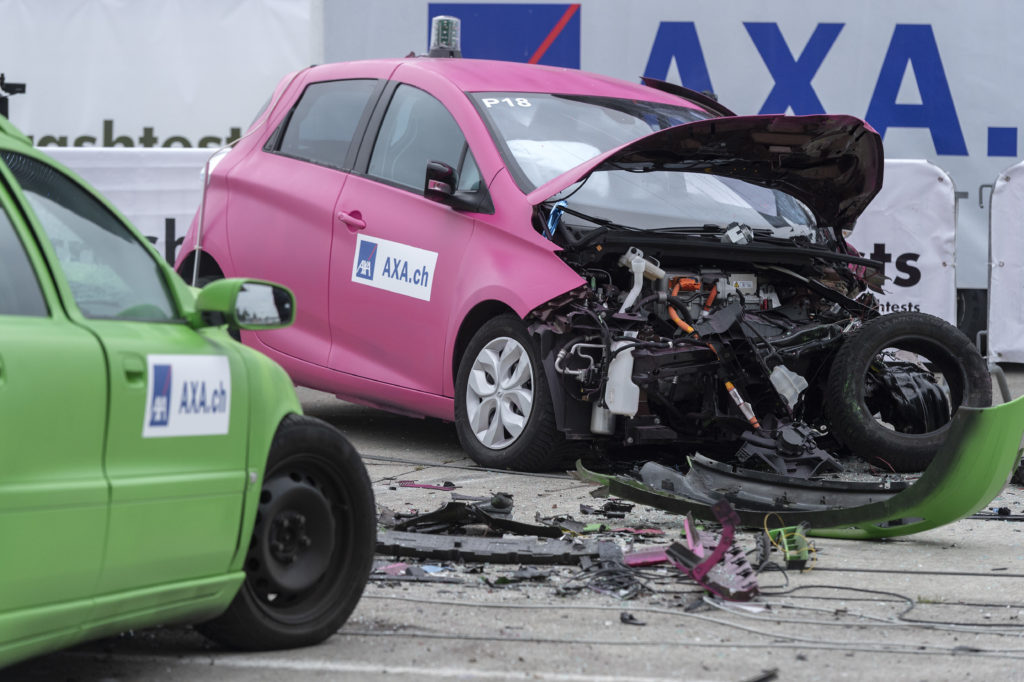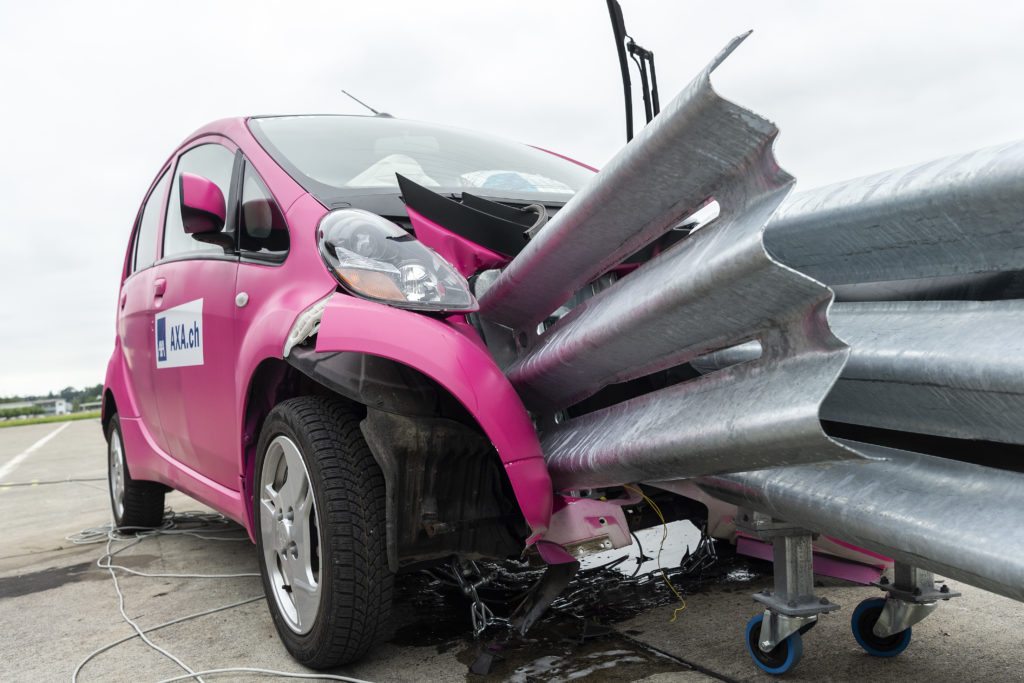
AXA: Electric cars could mean more crashes
By onAnnouncements | Education | Insurance | Market Trends | Repair Operations | Technology
The Swiss arm of insurer AXA last month reported “luxury car/SUV” electric vehicles post around a 40 percent higher claims frequency than vehicles with conventional powertrains.
However, “microclass/small vehicle” electric vehicles saw around 10 percent fewer claims, according to an Aug. 22 blog post.
Since we Americans tend to like buying larger vehicles, it sounds like increased electrification here could work out to better crash volume — at least until drivers get used to the vehicles.
Electric powertrains allow a vehicle to leap off the starting line without regard to engine speed. The 2018 Chevrolet Bolt, for example, can reach 60 mph in 6.5 seconds, according to US News & World Report.
“Maximum acceleration is available immediately, whereas it even takes powerful combustion engines a moment longer before they reach their maximum acceleration. This places new demands on drivers,” AXA head of accident research and prevention Bettina Zahnd said, according to the insurer.
AXA said half of the electric car drivers they surveyed said “they had to change the way they drive due to the different braking and acceleration behavior.”
The insurer crash-tested a scenario where someone trying to accelerate “slightly” before a curve on what AXA calls a “freeway.” The car’s speed rises quicker than expected, and the driver flies into the other lane to hit another vehicle head-on at nearly 44 mph.
“Both cars are severely deformed,” AXA wrote. “Although the drivers are protected as much as possible thanks to their seat belts and airbags, they can both be expected to sustain moderate to severe injuries.”
AXA also raised the possibility of a battery fire during a collision, apparently even if the vehicle isn’t under voltage.
“Although e-cars do not burn more often than other vehicles, if a battery catches fire, it burns very quickly and is very difficult to extinguish,” Zahnd said, according to AXA.
Another electric crash scenario proposed by AXA is about to be alleviated by a new regulatory requirement in the U.S. However, the solution could mean more repair severity and complexity if the technology required is affected by another type of crash.
Electric car motors are extremely quiet, and so in a backing situation, a pedestrian might not hear the vehicle coming and get out of the way. If the driver doesn’t see the pedestrian, a crash is possible. AXA simulated such a crash with an elderly woman with a walker.
However, the National Highway Traffic Safety Administration has required all hybrid and electric vehicles manufactured Sept. 1, 2020, to make noise up to 18.6 mph or in reverse. A phase-in period has already started; as of Sept. 1, 2019, half of the hybrid or electric vehicles needed to be in compliance.
A new proposal unveiled Tuesday would allow more flexibility for the driver to select compliant sounds; NHTSA is currently taking comments on the idea.
“In particular, NHTSA seeks comment on the potential safety issues related to HEV recognition by pedestrians if a multitude of new compliant driver-selectable sounds are available, and the extent to which having an unlimited number of sounds would lead to the potential for a pedestrian’s inability to identify the sounds as a motor vehicle,” the agency wrote.
It said the Alliance of Automobile Manufacturers and the Association of Global Automakers have suggested a maximum of five sounds per operating condition. The proposal wouldn’t allow aftermarket modification of the sounds.
Learn more about vehicle technology and trends at Repairer Driven Education
Find out more about vehicle technology and trends at SEMA with “Repair process 2020” featuring Doug Craig of LORD at 9:30-11:30 a.m. and “Mobility: The Future of Automotive Protection and Beautification,” with Jennifer Boros, Gareth Hughes and Ranju Arya of PPG” at 3-5 p.m. Tuesday, Nov. 5; and “Auto industry disruption: Win despite change!” with Frank Terlep of asTech on 9:30-11:30 a.m. on Wednesday, Nov. 6. The sessions are part of the Society of Collision Repair Specialists Repairer Driven Education Series running Nov. 4-8. Register here for individual courses or the series pass package deal, which includes the entire week of classes, all three parts of the OEM Summit, IDEAS Collide and the Nov. 7 Sky Villa afterparty.
NHTSA when it developed the rule in 2016 estimated it would cost an consumer $125.34 worth of technology on a hybrid without the technology and $50.49 to render a vehicle already sporting a similar technology compliant.
“This estimate includes the cost of a dynamic speaker system that is packaged for protection from the elements and that is attached with mounting hardware and wiring in order to power the speaker(s) and receive signal inputs, and a digital signal processor that receives information from the vehicle regarding vehicle operating status (to produce sounds dependent upon vehicle speed, for example.)” NHTSA wrote in 2016, though it noted that manufacturers thought speakers were more expensive than the agency thought. “We assume there will be no other structural changes or installation costs associated with complying with the rule’s requirements.”
Finally, AXA found that electric car users tend to embrace advanced driver assistance system technology — perhaps to the point that it causes them to get into crashes.
“Of course, all new vehicle models as well as e-cars are equipped with assistance systems, but e-car drivers are generally more interested in technical innovations, know more about assistance systems and use them more often, according to a comparison of survey results of e-car drivers and others,” AXA wrote.
Like the Insurance Institute for Highway Safety and a recent GM-University of Michigan study, AXA has found that ADAS like autobraking “may help protect accidents.” (It also classifies electronic stability control as ADAS, which is an accurate point that repairers and insurers might overlook.)
But it thought electric car drivers’ love of tech might lead to ADAS being used too liberally. State Farm research has raised a similar concern for the broader U.S. fleet by demonstrating a correlation between distracted driving and ADAS.
“Today there are already diverse cases of accidents that are assumed or known to have been caused by a driver’s over-reliance on a system,” AXA wrote.
The insurer said that “99 out of 100 e-car drivers whose cars are fitted with autopilot say that they also use it, more than half frequently or all the time, most frequently on the highway and for longer distances.”
Since the vehicle in the crash testing appears to be a Mitsubishi model, AXA appears to be using “autopilot” as a catchall for what it described as technology “which takes over the forward and sideways control,” and not a reference to the Tesla brand.
AXA’s third crash test represented a driver with such a system who mentally checks out while it’s activated.
All such systems in the U.S. require the motorist to continue to pay attention, and this is apparently the case in Switzerland too, for AXA writes that “under current legislation he is required to concentrate on the traffic at all times.”
The insurer described the oblivious motorist as hitting a “crash cushion” at 62 mph.
“The assistance system reaches the limit of its capacities at a highway intersection and immediately gives the driving task back to the driver. The driver has to react immediately, but as he wasn’t paying attention, he reacts too late,” AXA wrote. “… Although (the “crash cushion”) absorbs more energy than a concrete bollard, for example, the driver can be expected to sustain moderate to serious injuries from this hefty collision.”
More information:
AXA, Aug. 22, 2019
Images:
The Swiss arm of insurer AXA in August 2019 reported “luxury car/SUV” electric vehicles post around a 40 percent higher claims frequency than vehicles with conventional powertrains. However, “microclass/small vehicle” electric vehicles saw around 10 percent fewer claims, according to AXA. The insurer conducted crash tests of three potential types of electric vehicle collisions. (Melanie Duchene/KEYSTONE; Provided by AXA)
AXA Switzerland conducted crash tests of three potential types of electric vehicle collisions. In this one, a car’s speed rises quicker than expected, and the driver flies into the other lane to hit another vehicle head-on at nearly 44 mph. (Melanie Duchene/KEYSTONE; Provided by AXA)
Electric car motors are extremely quiet, and so in a backing situation, a pedestrian might not hear the vehicle coming and get out of the way. If the driver doesn’t see the pedestrian, a crash is possible. AXA simulated such a crash with an elderly woman with a walker. (Melanie Duchene/KEYSTONE; Provided by AXA)
AXA said this crash test simulated an oblivious motorist overrelying on ADAS along the lines of ProPILOT or Autopilot and hitting a “crash cushion” at 62 mph. (Melanie Duchene/KEYSTONE; Provided by AXA)




